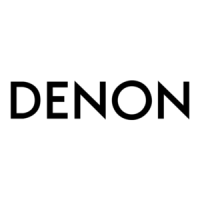38
AVR-4802/AVC-A11SR
Ref. No. Part No. Part Name Remarks Ref. No. Part No. Part Name Remarks
R169,170 247 2009 938 Carbon chip 6.2 kohm 1/16W RM73B--622JT
R171,172 247 2010 901 Carbon chip 12 kohm 1/16W RM73B--123JT
R175-178 247 2009 909 Carbon chip 4.7 kohm 1/16W
RM73B--472JT (1608)
R179,180 247 2011 942 Carbon chip 47 kohm 1/16W RM73B--473JT
R183 247 2007 943 Carbon chip 1 kohm 1/16W RM73B--102JT
R184 247 2011 942 Carbon chip 47 kohm 1/16W RM73B--473JT
R185,186 247 2018 903 Carbon chip 0 ohm 1/16W RM73B--0R0KT
R187,188 247 2006 902 Carbon chip 330 ohm 1/16W
RM73B--331JT (1608)
R189,190 247 2007 969 Carbon chip 1.2 kohm 1/16W RM73B--122JT
R191,192 247 2005 903 Carbon chip 100 ohm 1/16W RM73B--101JT
R195,196 247 2007 943 Carbon chip 1 kohm 1/16W RM73B--102JT
R197 247 2003 989 Carbon chip 33 ohm 1/16W RM73B--330JT
R198 247 2005 903 Carbon chip 100 ohm 1/16W RM73B--101JT
R199-204 247 2012 925 Carbon chip 100 kohm 1/16W RM73B--104JT
R205,206 247 2005 903 Carbon chip 100 ohm 1/16W RM73B--101JT
R207,208 247 2004 920 Carbon chip 47 ohm 1/16W RM73B--470JT
R209,210 247 2011 942 Carbon chip 47 kohm 1/16W RM73B--473JT
R211 247 2012 925 Carbon chip 100 kohm 1/16W RM73B--104JT
R212 247 2010 985 Carbon chip 27 kohm 1/16W RM73B--273JT
R213 247 2012 925 Carbon chip 100 kohm 1/16W RM73B--104JT
R214 247 2013 982 Carbon chip 470 kohm 1/16W RM73B--474JT
R215,216 247 2005 903 Carbon chip 100 ohm 1/16W RM73B--101JT
R217,218 247 2004 920 Carbon chip 47 ohm 1/16W RM73B--470JT
R219,220 247 2011 942 Carbon chip 47 kohm 1/16W RM73B--473JT
R221-224 247 2012 925 Carbon chip 100 kohm 1/16W RM73B--104JT
R225,226 247 2005 903 Carbon chip 100 ohm 1/16W RM73B--101JT
R227,228 247 2004 920 Carbon chip 47 ohm 1/16W RM73B--470JT
R229,230 247 2011 942 Carbon chip 47 kohm 1/16W RM73B--473JT
R231-234 247 2012 925 Carbon chip 100 kohm 1/16W RM73B--104JT
R235,236 247 2005 903 Carbon chip 100 ohm 1/16W RM73B--101JT
R237,238 247 2004 920 Carbon chip 47 ohm 1/16W RM73B--470JT
R239,240 247 2011 942 Carbon chip 47 kohm 1/16W RM73B--473JT
R241 247 2010 956 Carbon chip 20 kohm 1/16W RM73B--203JT
R242-247 247 2018 903 Carbon chip 0 ohm 1/16W RM73B--0R0KT
R250 247 2018 903 Carbon chip 0 ohm 1/16W RM73B--0R0KT
R308-310 247 2018 903 Carbon chip 0 ohm 1/16W RM73B--0R0KT
R311-313 247 2009 983 Carbon chip 10 kohm 1/16W RM73B--103JT
R314-316 247 2018 903 Carbon chip 0 ohm 1/16W RM73B--0R0KT
R317 247 2009 983 Carbon chip 10 kohm 1/16W RM73B--103JT
R318 247 2018 903 Carbon chip 0 ohm 1/16W RM73B--0R0KT
R319-322 247 2008 900 Carbon chip 1.8 kohm 1/16W RM73B--182JT
R323-330 247 2008 913 Carbon chip 2 kohm 1/16W RM73B--202JT
R333,334 247 2005 974 Carbon chip 200 ohm 1/16W RM73B--201JT
R337,338 247 2012 925 Carbon chip 100 kohm 1/16W RM73B--104JT
R339,340 247 2007 914 Carbon chip 750 ohm 1/16W RM73B--751JT
R341,342 247 2005 974 Carbon chip 200 ohm 1/16W RM73B--201JT
R343-346 247 2011 900 Carbon chip 33 kohm 1/16W RM73B--333JT
R347 247 2007 943 Carbon chip 1 kohm 1/16W RM73B--102JT
R348 247 2011 942 Carbon chip 47 kohm 1/16W RM73B--473JT
R351-353 247 2009 983 Carbon chip 10 kohm 1/16W RM73B--103JT
TR812,813 273 0384 900 Transistor 2SC2412KT96(S)
TR814 271 0238 908 Transistor 2SA1037KT96(S/R)
TR815 273 0384 900 Transistor 2SC2412KT96(S)
TR816 274 0163 904 Transistor 2SD601A
TR817 273 0384 900 Transistor 2SC2412KT96(S)
TR818 271 0238 908 Transistor 2SA1037KT96(S/R)
TR819 273 0384 900 Transistor 2SC2412KT96(S)
TR820,821 269 0193 901
Transistor KRC104S-RTK(47K-47K)
TR822 269 0184 907 Transistor KRA102S-RTK
TR823 269 0193 901
Transistor KRC104S-RTK(47K-47K)
D101,102 276 0739 907 Diode KDS181-RTK(A-COM)
D301-304 276 0740 909 Diode KDS184-RTK(K-COM)
D802,803 276 0739 907 Diode KDS181-RTK(A-COM)
D804,805 276 0704 903 Diode 1SR35-400A(T93X)
ZD801 276 0693 946 Zener diode UDZ3.0B
SC101 279 0016 904 Thyristor SF0R1A42(TPE2)
RESISTORS GROUP
R101-106 247 2005 945 Carbon chip 150 ohm 1/16W RM73B--151JT
R107-109 247 2005 903 Carbon chip 100 ohm 1/16W RM73B--101JT
R110-114 247 2009 909 Carbon chip 4.7 kohm 1/16W
RM73B--472JT (1608)
R115 247 2008 926 Carbon chip 2.2 kohm 1/16W RM73B--222JT
R116,117 247 2011 942 Carbon chip 47 kohm 1/16W RM73B--473JT
R118 247 2008 926 Carbon chip 2.2 kohm 1/16W RM73B--222JT
R119 247 2011 942 Carbon chip 47 kohm 1/16W RM73B--473JT
R120 247 2008 926 Carbon chip 2.2 kohm 1/16W RM73B--222JT
R122 247 2005 903 Carbon chip 100 ohm 1/16W RM73B--101JT
R123 247 2014 965 Carbon chip 1 Mohm 1/16W RM73B--105JT
R124-126 247 2005 903 Carbon chip 100 ohm 1/16W RM73B--101JT
R127 247 2011 900 Carbon chip 33 kohm 1/16W RM73B--333JT
R128 247 2003 989 Carbon chip 33 ohm 1/16W RM73B--330JT
R129,130 247 2018 903 Carbon chip 0 ohm 1/16W RM73B--0R0KT
R131,132 247 2005 903 Carbon chip 100 ohm 1/16W RM73B--101JT
R134 247 2005 903 Carbon chip 100 ohm 1/16W RM73B--101JT
R135 247 2018 903 Carbon chip 0 ohm 1/16W RM73B--0R0KT
R138 247 2009 983 Carbon chip 10 kohm 1/16W RM73B--103JT
R142 247 2018 903 Carbon chip 0 ohm 1/16W RM73B--0R0KT
R143 247 2009 967 Carbon chip 8.2 kohm 1/16W RM73B--822JT
R144 247 2008 955 Carbon chip 3 kohm 1/16W RM73B--302JT
R145 247 2009 912 Carbon chip 5.1 kohm 1/16W RM73B--512JT
R146 247 2004 975 Carbon chip 75 ohm 1/16W RM73B--750JT
R147-149 247 2003 989 Carbon chip 33 ohm 1/16W RM73B--330JT
R150 247 2005 903 Carbon chip 100 ohm 1/16W RM73B--101JT
R151-154 247 2018 903 Carbon chip 0 ohm 1/16W RM73B--0R0KT
R155-162 247 2005 903 Carbon chip 100 ohm 1/16W RM73B--101JT
R163,164 247 2009 983 Carbon chip 10 kohm 1/16W RM73B--103JT
R167,168 247 2006 960 Carbon chip 470 ohm 1/16W RM73B--471JT
w
w
w
.
x
i
a
o
y
u
1
6
3
.
c
o
m
Q
Q
3
7
6
3
1
5
1
5
0
9
9
2
8
9
4
2
9
8
T
E
L
1
3
9
4
2
2
9
6
5
1
3
9
9
2
8
9
4
2
9
8
0
5
1
5
1
3
6
7
3
Q
Q
TEL 13942296513 QQ 376315150 892498299
TEL 13942296513 QQ 376315150 892498299
http://www.xiaoyu163.com
http://www.xiaoyu163.com

